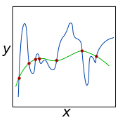Subspace recycling techniques have been used quite successfully for the acceleration of iterative methods for solving large-scale linear systems. These methods often work by augmenting a solution subspace generated iteratively by a known algorithm with a fixed subspace of vectors which are ``useful'' for solving the problem. Often, this has the effect of inducing a projected version of the original linear system to which the known iterative method is then applied, and this projection can act as a deflation preconditioner, accelerating convergence. Most often, these methods have been applied for the solution of well-posed problems. However, they have also begun to be considered for the solution of ill-posed problems. In this paper, we consider subspace augmentation-type iterative schemes applied to linear ill-posed problems in a continuous Hilbert space setting, based on a recently developed framework describing these methods. We show that under suitable assumptions, a recycling method satisfies the formal definition of a regularization, as long as the underlying scheme is itself a regularization. We then develop an augmented subspace version of the gradient descent method and demonstrate its effectiveness, both on an academic Gaussian blur model and on problems arising from the adaptive optics community for the resolution of large sky images by ground-based extremely large telescopes.
翻译:子空间再循环技术被非常成功地用于加速解决大型线性系统的迭代方法的加速。这些方法通常通过增加已知的算法和固定的矢量子空间的“有用”的子空间来迭代生成的溶液子空间而发挥作用。通常,这产生的结果是,最初的线性系统的预测版本,当时已知的迭代方法应用到这个系统,这种预测可以起到通货紧缩的先决条件作用,加速趋同。这些方法通常被用于解决大量存在的问题。然而,这些方法也已开始被考虑解决错误的问题。在本文中,我们考虑子空间扩增型迭代方案在连续的Hilbert空间设置中适用于线性不测的问题,其基础是描述这些方法的最近制定的框架。我们表明,在适当的假设下,回收方法符合正规化的正式定义,只要基本方案本身是正规化的。我们随后开发了梯度下降方法的增强的子空间版本,并展示其有效性,既以学术高估模型为基础,又以大规模地面图像适应性地面分辨率产生的问题。



